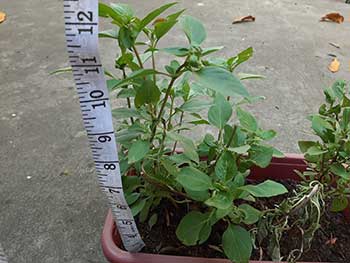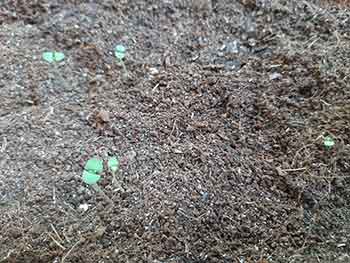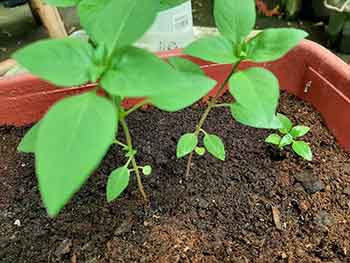In my experience, basil is one of the easiest herbs to grow in the garden. They grow very fast, in fact, you can have your first harvest in 2 months. I grow basil for its fresh, minty flavor and distinct aroma. It is indeed a welcome addition to the kitchen, especially when it is fresh.
When growing basil in pots, how much space do they need to thrive? I planted some seeds in one of my containers, just to see if basil can really grow in tight spaces. Basil needs 4 inches of space, with a soil depth of 4 inches, in order to flourish. The potting soil should have good porosity and water holding capacity to support the basil’s roots. When planted in a pot with this space and soil type consideration, it can grow to at least 12 inches or 1 foot in height in 3 months.
I made some research on the internet about this one, and most of the sites recommend at least 6-8 inches between basil plants. However, based on the data that I gathered from my little experiment, you can grow basil with at least 4 inches of space.


How to Grow Basil in a Pot
I have always wanted to grow my own herbs at home. So when I had the chance to buy some basil seeds online, I immediately prepared a container just for them. The container I had at that time is a rectangular plastic one, which is 7 inches wide, 14 inches long, and 6 inches deep. However, when measured from the inside, I found out that it is really just 6 inches wide and 13 inches long. It was painted to look like a regular terracotta pot which is great for me.

I planted around 6 basil seeds on the 17th of November. I prepared my own potting mix of garden soil, wood chips, and coco peat and filled my container with it. My pot is 6 inches deep, however, I just filled about 4 inches of soil, leaving 2 inches of space at the top. I did this on purpose as I may apply mulch or some organic fertilizer later on when the plants have grown.
I just scattered the seeds on the topsoil and pressed them firmly with my index finger. I then poured water to keep the soil moist and to trigger the seeds to germinate. Lastly, I just left the pot in a shady area, away from direct sunlight. By the third day, most of the seeds have already germinated.

After 1 month, some plants already have 8 true leaves, while there is 1 plant that grows slower than the others with only 4 true leaves. Out of the 6 seeds that I sowed, only one did not germinate. By this time, 5 basil seedlings were growing in 1 container. I then transplanted 2 seedlings to another pot, so I have 3 basil seedlings left in my main pot.

The 3 basil seedlings are now planted in a container that is 6 inches wide, 13 inches long, and 4 inches deep. In other words, 3 basil plants are growing on 312 cubic inches of soil. That means, each basil plant will have 104 cubic inches of soil, which is actually not that much. Also with a container length of 13 inches, each basil plant can be spaced at about 4 inches.
By February 27, or about 3 months after sowing the seeds, my basil plants have now grown to about 12 inches in height. I had my first harvest on February 14, a little over 2 months, which I mixed into my fresh tomato sauce for pasta.

As a piece of additional information, you may instead grow basil from cuttings. You can read about it here.
Caring for Basil in a Pot
If I’m going to follow the recommendations on most sites, then I should only be able to plant at most 2 basil in my small pot. However, with proper care and nutrition, I was able to grow three basil in a small pot. There are three important factors that I think enabled me to grow basil in such a small space. These are the soil, nutrition, and sunlight.
For the soil, I made sure that the following characteristics are present:
- It should be porous. A soil with good porosity provides good air circulation and root development. If the soil is hard and dry, the roots cannot expand causing stunted growth. The loose texture is good for the roots in that it doesn’t have to spend more energy to spread to a larger area to look for nutrients.
- It should have a good water holding capacity. Since most nutrients are water-based, then it makes sense that the soil has to hold on to the water in the soil. Too much water movement may result in the loss of nutrients in the soil.
For more information on how to improve your garden soil, you may read this article.
The soil that I placed in my pot uses a ratio of 4:1:1:1. That is 4 cups soil, 1 cup coco peat, 1 cup wood chips, and 1 cup worm cast. This combination is a cheap, simple, and effective type of garden soil. This potting mix is what I put in most of my pots. If you do not have access to good soil or soil amendments, then you can simply buy a good potting mix such as Miracle-Gro Potting Mix.
I use this often when I run out of soil amendments such as wood chips or coco peat. It already has nutrients such as phosphate and nitrogen. Plus, it is free of pathogens. One characteristic of a good potting mix is that the soil has to be free from disease-causing organisms such as fungus or bacteria. Although there are some beneficial microorganisms that break down organic materials into fertilizers for the plants.
For nutrition supplements, I use my own homemade fertilizer if I have time. But occasionally, I use commercial fertilizers when I want to apply them immediately. If I have time, I use my grass-clipping tea fertilizer, which can be prepared after 3 days. You can read about how I make this fertilizer in this article. Aside from grass clippings, I also use the following homemade fertilizers:
In terms of sunlight, my basil plants are placed in an area where they received full sunlight between 6-8 hours a day. However, this dries up the soil easily, so be sure to keep the soil moist since the basil’s roots do not like dry soil.
Harvesting Basil Leaves

In just a little over 2 months, I was able to pick some fresh basil leaves in my garden. For my fresh tomato sauce recipe, I picked a handful of leaves, a mixture of young and old leaves. It is still growing and now I have a year-round supply of fresh basil for my kitchen.










